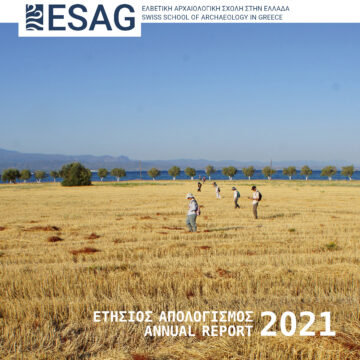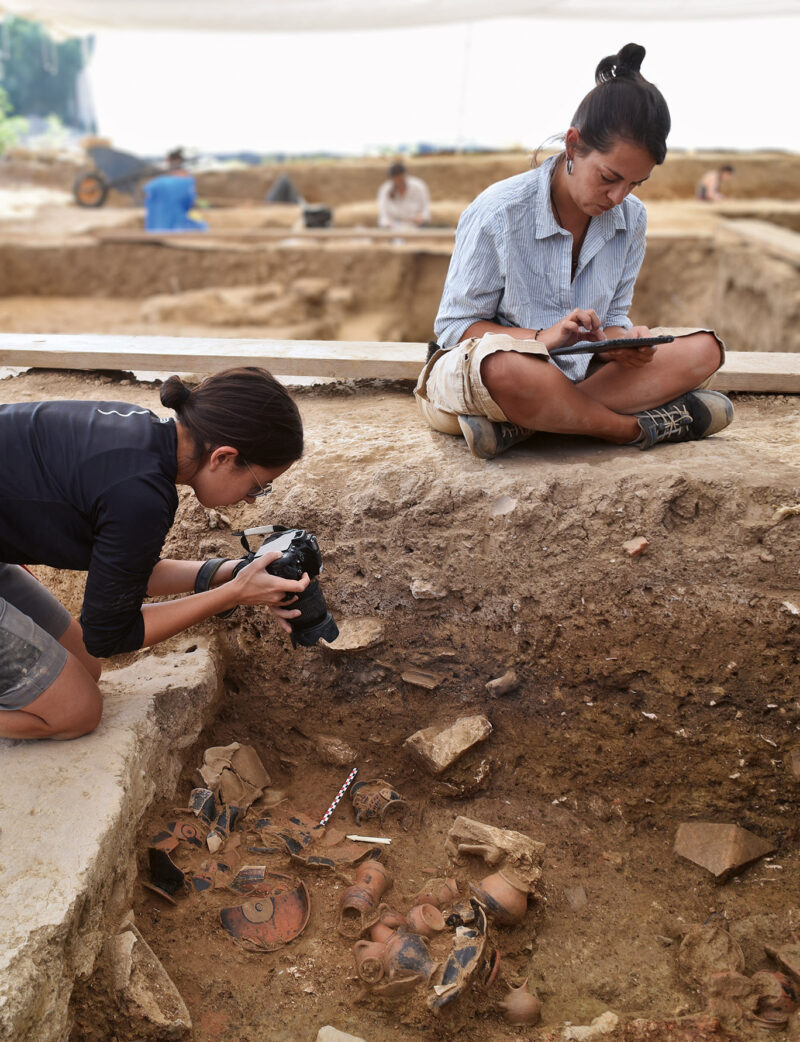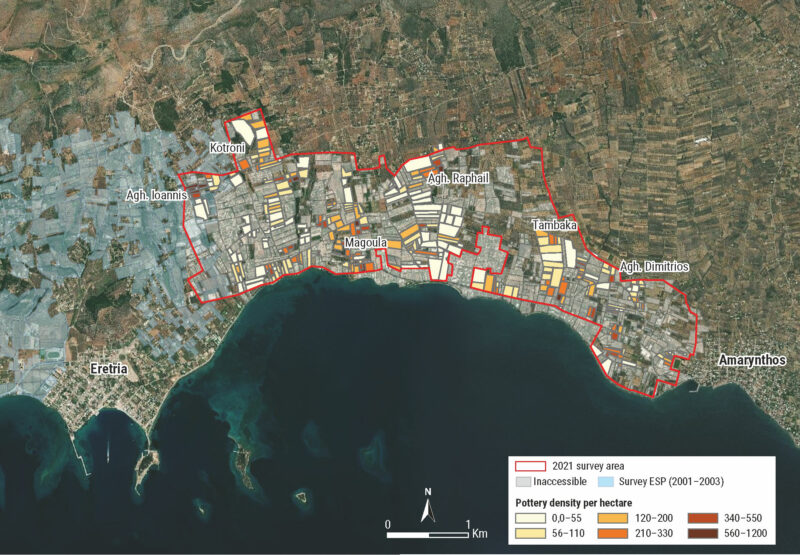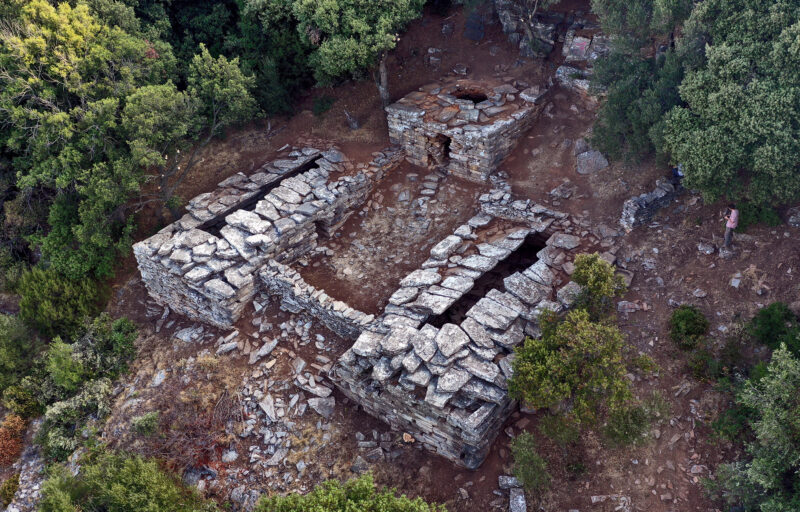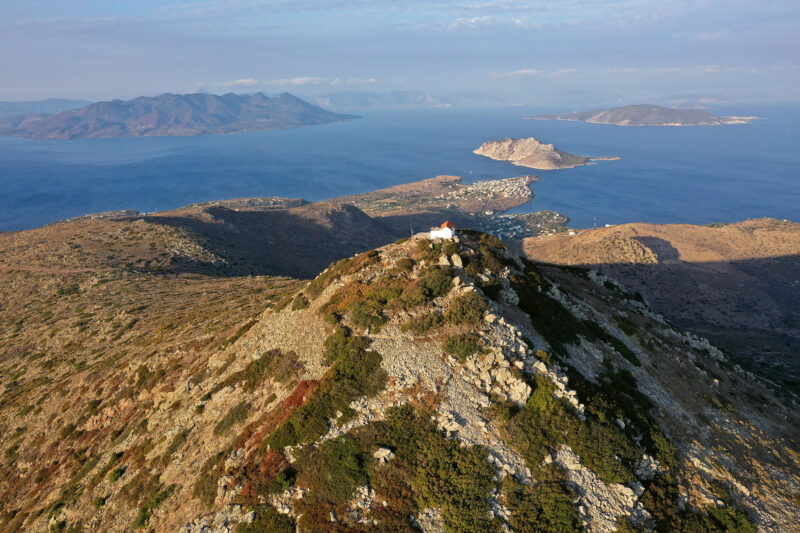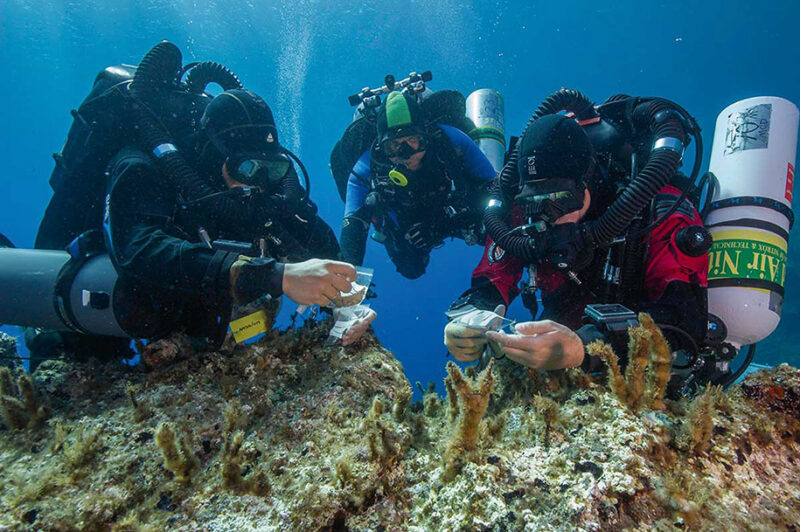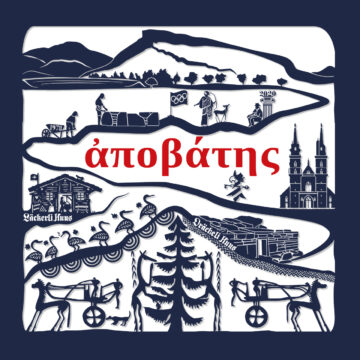Fieldwork 2021
Despite the Covid-19 pandemic and the tragic fires that ravaged Greece and Euboea in particular, the year 2021 was driven by the will to return to normality, especially with respect to fieldwork. The Swiss School of Archaeology successfully carried out excavations and surveys at Amarynthos and Ilkizes in Euboea as well as on Mount Oros on Aegina and off the island of Antikythera.
These fieldwork activities, together with other research projects carried out by ESAG members, reflect the dynamism of Swiss archaeology in Greece, as the country celebrates the bicentenary of the War of Independence.
The excavation at the Artemision of Amarynthos (Euboea)
The 2021 excavation campaign at the Artemision marks the beginning of a new four-year program at Amarynthos, conducted by the ESAG in collaboration with the Ephorate of Antiquities of Euboea. Research now focuses on the earliest phases of occupation. The prehistoric settlement on the Palaeoekklisies hill, as well as the Geometric and Archaic structures in the sanctuary are under study, with the objective of understanding the beginnings and development of Amarynthos. In order to be able to reconstruct the surrounding landscape of the Artemision, the excavation is supplemented by an intensive archaeological survey.
The prehistoric site on Paleoekklisies
The existence of a prehistoric site on the hill east of the sanctuary of Artemis in Amarynthos was already known due to the British and Greek fieldworks carried out in the 1960s. This year, the acquisition of two plots on the slopes of the hill allowed the extension of the excavation towards this area, in an effort to understand the link between the Bronze Age settlement and the sanctuary of the 1st mil. BC. In 2021, the excavation focused on two separate sectors and brought to light rich material evidence dating to the 3rd and 2nd mil. BC. A strong wall, possibly forming part of the site’s fortification, was unearthed on the lower part of the hill slopes. Near the top of the hill, trial trenches confirmed the site’s occupation in the Myceanean era and brought to light a rectangular building and about ten graves of the Medieval period.
The Archaic temples of Artemis
The 2020–2021 investigations focused on the excavation of the temple of Artemis, where a rich votive deposit buried during the reconstruction of the edifice towards the end of the 6th c. BC was found. More than 600 finds were recovered: Attic black-figure pottery, ritual miniature vases, terracotta statuettes, jewellery made of gold, silver, glass, faience and amber, bronze vessels and weapons. Walls were discovered under the temple foundations. They belong to an earlier cult building, oriented towards a horseshoe-shaped altar. Traces of fire and layers of charcoal with burnt bones were recovered on the altar and in its surrounding, testifying to animal sacrifices during the Archaic period.
Survey between Eretria and Amarynthos
The research program at Amarynthos was extended this year by the addition of an intensive archaeological survey, which should contribute to a better understanding of the sanctuary’s introduction in the surrounding ancient landscape. More than 300 plots, of a total area of 2.16 km2, were intensively prospected. The survey was complemented by archaeological terrain recognition based on LiDAR technology. Several archaeological sites from the end of the Neolithic and the beginning of the Bronze Age, as well as four previously unknown sites from the Archaic period, were discovered between Eretria and Amarynthos. At least three demes belonging to Eretria could also be located. These sites were all established between the Hellenistic and Byzantine periods. The position of the most important settlements, as well as the funerary monuments, make it possible to trace the communication arteries and especially the Sacred Way from Eretria to the Artemision of Amarynthos.
Fieldwork on the “Dragon house” of Euboea
The Greek-Swiss project in the region of Styra focuses on a particular type of dry-stone rural buildings located in the mountain range of Southern Euboea, the so-called drakospita or “dragon houses.” In 2021, the complex at Palli-Lakka was surveyed and the Drakospito of Ilkizes was excavated. The few fragments found in the the construction fill, date it to the 4th c. BC at the earliest. Numerous bones, the remains of a hearth and pottery sherds dating to the Classical and Late Hellenistic periods were found on the floor level. The study of this material does not provide enough evidence for the identification of this building. However, the architecture and location of the Drakospito find close parallels with modern sheepfolds found in the region. In addition to the excavation at Ilkizes, fieldwork focused on documenting three other Drakospita at Kroi-Phtocht, Loumithel and Palli-Lakka.
The ongoing project on the Drakospita of Southern Euboea will be continued in order to improve our understanding of these buildings and to promote development of these archaeological sites.
Fieldwork on mount Oros, Aegina
In 2021, the ESAG and the Ephorate of Antiquities of Piraeus & Islands inaugurated a five-year research program on the summit of mount Oros on the island of Aegina. The first investigations of the area, carried out during the first half of the 20th c., were not followed by a detailed publication. The archaeological remains located on the north slope of mount Oros were identified with the sanctuary of Zeus Hellanios, mentioned in ancient sources. On the top of the mountain, the ancient foundations found under the modern chapel could be linked to a small temple belonging to this sanctuary. The Greek-Swiss research program aims to investigate the Hellanion Oros, studying the use of the area over the centuries and the beginnings of the cult of Zeus, which may date back to the Bronze Age.
Underwater fieldwork at Antikythera
In 1900, a shipwreck with a cargo containing numerous works of art and luxury objects was discovered near the island of Antikythera. The finds included the famous astronomical mechanism of Antikythera, which has not to this day revealed all of its secrets. The shipwreck, excavated several times in the past, was again scientifically investigated between 2014 and 2019. A new project in collaboration with scientists from Greece, Switzerland and Italy is currently underway. Its goal is to bring together the available documentation and develop a new 3D model in an attempt to better understand the course of the ship’s sinking.
Return to Antikythera projectἀποβάτης – Collection of Essays in Honor of Karl Reber
Edited by Guy Ackermann – Tobias Krapf – Laureline Pop
Karl Reber has been exploring the rich cultural heritage of the Greek island of Euboea for more than forty years. He was director of the Swiss School of Archaeology in Greece from 2007 to 2021 and conducted several excavations in Eretria and Amarynthos. On the occasion of his 65th birthday and his retirement after fifteen years as a Professor at the University of Lausanne, his former students dedicate a collection of essays to him, entitled ἀποβάτης. The twenty-three contributions are devoted to ancient finds, recent discoveries and new ideas on the ancient city of Eretria, the nearby sanctuary of Artemis Amarysia and the Euboean countryside from the Mycenaean to the Imperial period.
ἀποβάτης